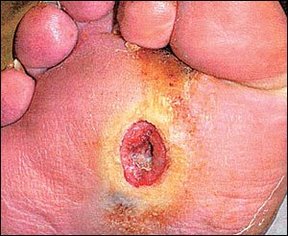
In this study - a prospective cohort of 291 patients managed to current evidence-based guidelines in French hospitals - the authors concluded:
"Most of the wounds were located on the toes and forefoot, and infection was most often graded as moderate; nevertheless, in about 50% of patients, osteomyelitis was suspected. Also, 87% of patients had peripheral neuropathy and 50-62% had peripheral artery disease. Gram-positive cocci, and Staphylococcus aureus in particular, were by far the most frequently isolated microorganisms. During hospitalization, lower-limb amputation was performed in 35% of patients; in 52%, the wound healed or had a favourable outcome. A year after discharge, 150 non-amputated patients were examined: at this time, 19% had to undergo amputation, whereas 79% had healed their wounds with no relapse. Risk factors for amputation were location (toes), severity of the wound and presence of osteomyelitis. Peripheral artery disease was associated with a poor prognosis, yet was very often neglected.
In spite of being managed at specialized centres that were, in general, following the agreed-upon published guidelines, the prognosis for diabetic foot infection remains poor, with a high rate (48%) of lower-limb amputation."
1. Richard J-L, Lavigne J-P, Got I, Hartemann A, Malgrange D, Tsirtsikolou D, Baleydier A, Senneville E. Management of patients hospitalized for diabetic foot infection: results of the French OPIDIA study. Diabetes Metab. 2011 Jun;37(3):208-215. Available from: http://www.ncbi.nlm.nih.gov/pubmed/21169044
There four optional modes that include rolling, kneading and massaging combinations. Moreover, there are 3 modes that allow you to target tiptoe, arch or sole sole of the foot. best foot massager 2017
ReplyDeleteVery informative post. Calluses also may lead to infection if you are immunocompromised. Calluses are commonly formed due to lot of rubbing against hands or feet. Plantar calluses are more common, found on the bottom of the foot. Thick calluses on foot are preventable at the early stage by everyday home care. Also you can treat your calluses by following our instruction, so visit our site to know more about foot care.
ReplyDelete